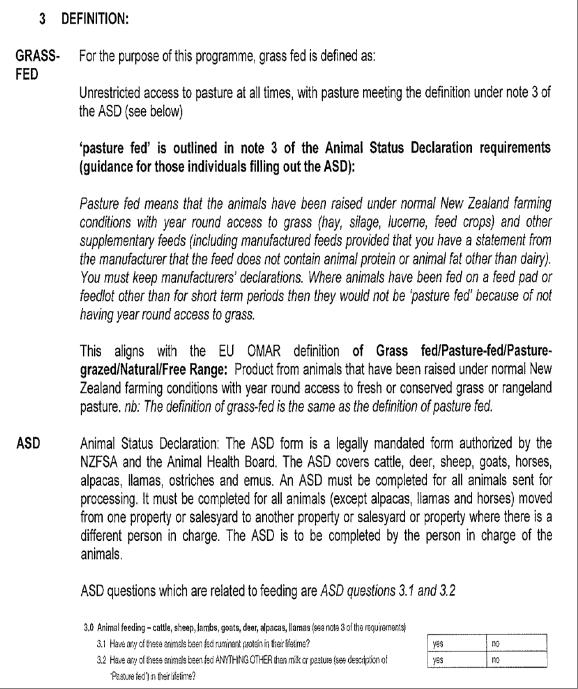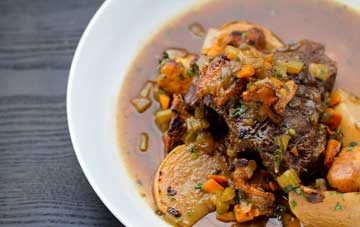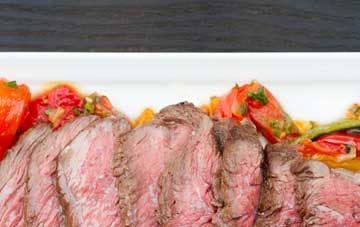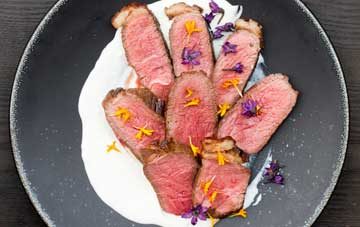While you would think “grass-fed” means the same thing everywhere, legally the exact wording of the government’s definition is important because it defines whether you can use the term. Here we’ve collected both the US & New Zealand governments’ definitions, so you can see the differences.
US vs NZ Definitions of “Grass-Fed” at a Glance
What are “Incidental Supplementation” & “Supplementary Feeds”? Both definitions include the term “supplementation” or “supplementary feeds”. What does that mean? As far as we can tell, in the US it can mean pretty much anything.
While it is technically permissible to include grain in “supplementary feed” in New Zealand – pragmatically speaking it’s impractical and not used. In New Zealand, grass is plentiful, convenient, and cheap. Grain, on the other hand, is expensive & unsubsidized, making it prohibitive.
Exact “Grass-Fed” Definitions in Depth:
The NZ definition of “Grass-Fed” (as of 7/1/13) is closer to the EU definition:

The USDA Standard (per FSIS) for “Grass-Fed” (as of 7/16/13) is:
Grass (Forage) Fed – Grass and forage shall be the feed source consumed for the lifetime of the ruminant animal, with the exception of milk consumed prior to weaning. The diet shall be derived solely from forage consisting of grass (annual and perennial), forbs (e.g., legumes, Brassica), browse, or cereal grain crops in the vegetative (pre-grain) state. Animals cannot be fed grain or grain byproducts and must have continuous access to pasture during the growing season. Hay, haylage, baleage, silage, crop residue without grain, and other roughage sources may also be included as acceptable feed sources. Routine mineral and vitamin supplementation may also be included in the feeding regimen. If incidental supplementation occurs due to inadvertent exposure to non-forage feedstuffs or to ensure the animal’s well being at all times during adverse environmental or physical conditions, the producer must fully document (e.g., receipts, ingredients, and tear tags) the supplementation that occurs including the amount, the frequency, and the supplements provided. (Source)
US vs NZ Definitions of “Grass-Fed” at a Glance
|
USA |
NZ |
|
| Free Range Requirement | “continuous access to pasture during the growing season” | “unrestricted access to pasture at all times” |
| Feed Requirements | “forage consisting of grass (annual and perennial), forbs (legumes, Brassica), browse, or cereal grain crops in the vegetative (pre-grain) state”“If incidental supplementation occurs due to inadvertent exposure to non-forage feedstuffs or to ensure the animals well being at all times during adverse environmental or physical conditions, the producer must fully document…the supplementation that occurs…” | “grass (hay, silage, Lucerne, feed crops) and other supplementary feeds” |
| “Pasture-Raised” Definition | Unregulated | Required to be on pasture to be “grass-fed” |
What are “Incidental Supplementation” & “Supplementary Feeds”? Both definitions include the term “supplementation” or “supplementary feeds”. What does that mean? As far as we can tell, in the US it can mean pretty much anything.
While it is technically permissible to include grain in “supplementary feed” in New Zealand – pragmatically speaking it’s impractical and not used. In New Zealand, grass is plentiful, convenient, and cheap. Grain, on the other hand, is expensive & unsubsidized, making it prohibitive.
Exact “Grass-Fed” Definitions in Depth:
The NZ definition of “Grass-Fed” (as of 7/1/13) is closer to the EU definition:

The USDA Standard (per FSIS) for “Grass-Fed” (as of 7/16/13) is:
Grass (Forage) Fed – Grass and forage shall be the feed source consumed for the lifetime of the ruminant animal, with the exception of milk consumed prior to weaning. The diet shall be derived solely from forage consisting of grass (annual and perennial), forbs (e.g., legumes, Brassica), browse, or cereal grain crops in the vegetative (pre-grain) state. Animals cannot be fed grain or grain byproducts and must have continuous access to pasture during the growing season. Hay, haylage, baleage, silage, crop residue without grain, and other roughage sources may also be included as acceptable feed sources. Routine mineral and vitamin supplementation may also be included in the feeding regimen. If incidental supplementation occurs due to inadvertent exposure to non-forage feedstuffs or to ensure the animal’s well being at all times during adverse environmental or physical conditions, the producer must fully document (e.g., receipts, ingredients, and tear tags) the supplementation that occurs including the amount, the frequency, and the supplements provided. (Source)


